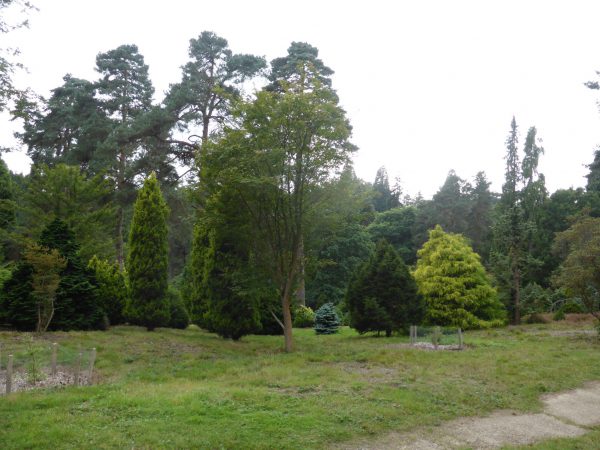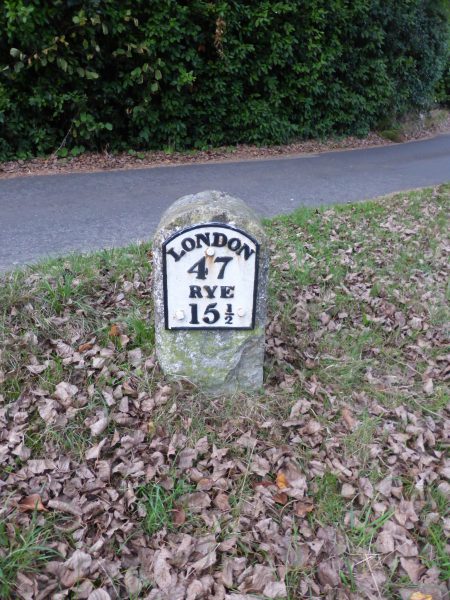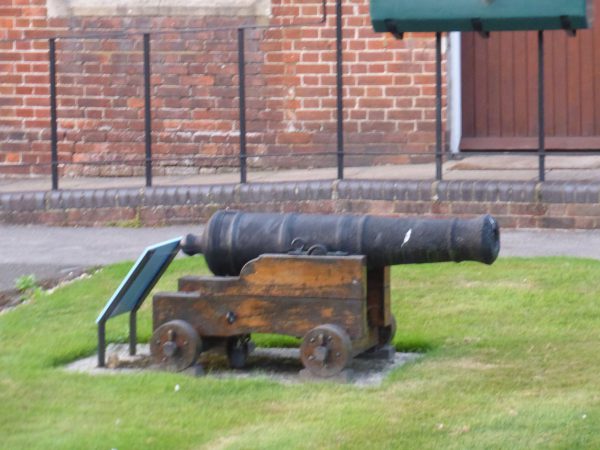There is always something special about exploring a new part of the Country. Neither of us know this area so our stay here feels like being on holiday and we are keen to get out and explore. My early morning stroll with the boys from Waghorns CL was a pleasant mile or two loop around local paths.
It is early afternoon when we head off for our walk. Having looked at the map we agree our starting point should be Hawkhurst for no other reason than it is an interesting place name. The drive is straightforward and along the way we see many weather boarded buildings, this is a key theme of the local architecture. As you travel around the country you see many different styles and approaches to building, in some places you can define the area you are in by the predominant style and materials. I am not talking about modern estates they appear similar countrywide, but the older traditional buildings.
We park in a public car park in Hawkhurst (just beyond Tesco’s) and then walk back towards the village centre. Taking the first right after Tesco’s we follow the lane downhill and then take a footpath on our left. On reaching a road we cross and take the road directly in front of us (Ockley Lane) as the tarmac road bends to the right we continue downhill and soon join a rough track descending towards Ockley. After crossing a stream the track gradually climbs towards Beal’s Green. On meeting a minor road we turn left and follow this route as it passes a construction site for the development of a new care home.
We reach the A229 and cross with caution to join the minor road on the opposite side. Soon we pass The Great House pub where I spot a hedgehog crossing the car park. It is a long time since I saw a live hedgehog. Unfortunately they are in sharp decline. There are many reasons why this is happening, including road deaths, poisoning from slug pellets and the increasing number of their natural predators, the badger.
On reaching the end of the lane we arrive at a T-junction and turn left and in less than a hundred yards climb some steps to join a path between fences. This leads us to a stile close to woodland. Unfortunately, it a stile where the landowner has decided to make it difficult for dogs. So the boys are lifted over, this is repeated at the next stile. By now I am cursing the inconsiderate nature of landowners, a simple dog gate is easy to fit!
We soon arrive at a track and turn right heading downhill to a field with a sign that warns of the presence of a bull. All we can see are a few pheasants so we cross the field to a footbridge over a stream and then follow the path as it rises gradually. This brings us to another field with recent evidence of bears.
We are always cautious around bears, they appear to have a particular interest in Crosby, so we proceed with trepidation. Lynnie acts as the advance guard going ahead whilst I count the paces from the stile. Despite all the cowpats we see no bears as we go through the field, first with the hedge on our left and then after passing through an open gateway with it to our right. After another stile we head down to a lane. We spot some interesting fungi growing in the hedgerow. It is bright red suggesting danger to me.

Turning right we walk steadily uphill passing Sopers Farm, at a bend in the lane we sweep right passing the entrance to Silsey Farm on our left. At a junction of paths we turn left and follow this route through a game conservation area. The game has been well conserved and the landowners are being kind enough to feed them. How thoughtful!
The track follows through trees and the odd section is slightly boggy (despite all the recent dry weather). We pass a clearing where plenty of ducks are enjoying the afternoon sun by the stream, we wonder if these game are also being conserved?

We arrive at a junction of paths by a pond and turn right. This is a pretty little spot in the woodland. Our route soon rises away from the pond and passes Frith Farm. We pass a field with a huge number of ducks, me thinks these are being conserved for a reason!

We now contine along the track in the woodland, whereby I announce that whilst an interesting walk it is not a patch on being in the Yorkshire Dales (where we were this time last year). That’s not to suggest we are not enjoying our bit of out, it’s just that walking in woodland is not always the most stimulating.
We continue on ignoring paths to our left until we meet a T junction of paths. Here we turn left to pass Louisa Lodge on our right. We now continue along this route until we reach Bedgebury National Pinetum.

I have not heard of a pinetum so I turn and ask Lynnie, who is a lot cleverer than me and knows lots of stuff! Within seconds, from behind me, she tells me all about a pinetum. It is a collection of pine trees. Stupid me I should have guessed – but it appeared too obvious.
According to the Forestry Commission website the Bedgebury National Pinetum covers 320 acres and contains over 12,000 trees and shrubs, including 1,800 different species from across five continents, many of these trees and shrubs are rare or endangered.
Apparently this pinetum was established in 1925 and is now thought to be the largest collection of conifers growing on one site anywhere in the world. I have never heard of it, you learn something new everyday, as the say.

From the Pinetum we take a footpath heading south through Bedgebury Forest, it rises over the interestingly named Starvegoose Bank. Lynnie spots that the heather is just coming into flower.
As the path sweeps to the right there are two broad tracks together leading to the left, we take the second one of these and follow this route down, continuing straight on at a crossing of paths. At the next junction of paths we turn right to go downhill and nearing a stream we take a path on our left. It is obvious that sections of this path must be extremely boggy in wet conditions, but today it is not too difficult. At the end of the track we turn left and then quickly right at a finger post to follow a narrow path through the trees emerging at a gate. This leads to a fenced path with the woods on our left and open farmland on our right.
The route from here follows the track to Little Pix Hall Farm and then on to Elm Hill Farm after which we reach the A268. We cross the road to follow the narrow lane opposite and are immediately surprised by the number of cars. At cottages on our right a helpful local warns us that there has been a car accident in the vicinity and this route is being used as a diversion. He suggests that today it might be a treacherous route into Hawkhurst. We therefore, take the alternative route along the A268. Luckily there is a wide verge and although the road is busy it does not hamper our progress too much and we are soon on the edge of the village.
Just as the speed restrictions start there is a pavement on the opposite side for us to walk into the village. The first building of interest we notice is the Hawkhurst Community Hospital. This was built in 1887 gifted from Margaret Adams, the widow of a local surgeon Richard Dering Adams. Mr Adams died in 1866 and his wife in 1887, they had no children but they left their mark on the local community with their generous donation.
After passing an old milestone that tells us we are 47 miles from London and 15.5 from Rye we continue into the village.

It is interesting being somewhere different, after going over the busy crossroads we come to Dunk’s Almshouses. Sir Thomas Dunk was an ironmonger who was appointed Sheriff of London in 1711. Dunk lived in Hawkshurst and in his will endowed the village with six almshouses, a school for twenty boys and a house for the schoolmaster. His philanthropy does him credit to this day; offering homes to more than double the people, with the school room used as a meeting room. They are a fine set of buildings.

An old ship’s canon sits in the gardens of the almshouses; the inscription on the accompanying plaque describes it is an English Iron 3 pounder naval cannon made around 1750. Cannons were once forged at Hawkhurst but in earlier times than when this one was produced.

This has been a really interesting walk of just over nine miles; we have happily wandered around this part of East Sussex and from what we have seen so far it looks like we will enjoy our stay here.
To view this walk on OS Maps Click Here
To follow our walk you will need Ordnance Survey Explorer Map 136 – High Weld
20th September 2016
© Two Dogs and an Awning (2016)

